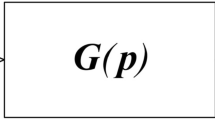Abstract
We state an optimal control problem for a class of dynamical systems whose nonlinear objects can be represented as objects with linear structure and state-dependent parameters. The linearity of the structure of the transformed nonlinear system and the quadratic performance functional allow one to move from the need to search for solutions of the Hamilton–Jacobi equation to an equation of the Riccati type with state-dependent parameters when synthesizing the optimal control, i.e., the controller parameters. The main problem of implementing the optimal control is related to the problem of being capable of finding solutions of such an equation online, at the object operation rate. An algorithmic method for the parametric optimization of the controller is proposed. The method is based on using the necessary optimality conditions for the control system in question. Our algorithms can be used both to optimize the time-varying objects themselves given an appropriate choice of the parameters for this purpose and to optimize the entire control system using an appropriate parametric adjustment of the controllers. The efficiency of the algorithms is demonstrated by the example of drug treatment of patients with HIV.


Similar content being viewed by others
REFERENCES
Malkin, I.G., Teoriya ustoichivosti dvizheniya (Motion Stability Theory), Moscow: URSS, 2004.
Krasovskii, N.N., Nekotorye zadachi teorii ustoichivosti dvizheniya (Some Problems of Motion Stability Theory), Moscow: Izd. Fiz.-Mat. Lit., 1959.
Isidori, A., Nonlinear Control Systems, London: Springer, 1995.
Khalil, H.K., Nonlinear Systems, New York: Prentice Hall, 2002.
Mehra, R., Chinde, V., Kazi, K., and Singh, N.M., Feedback linearization of single-input and multi-input control system, Proc. 19th World Congr. IFAC. (Cape Town, 2014), pp. 5479–5484.
Afanas’ev, V.N. and Orlov, P.V., Suboptimal control of feedback-linearizable nonlinear plant, J. Comput. Syst. Sci. Int., 2011, vol. 50, no. 3, pp. 365–374.
Pearson, J.D., Approximation methods in optimal control, J. Electron. Control, 1962, no. 12, pp. 453–469.
Cimen, T.D., State-dependent Riccati equation (SDRE) control: a survey, Proc. 17th World Conf. IFAC (Seoul, 2008), pp. 3771–3775.
Mracek, C.P. and Cloutier, J.R., Missile longitudinal autopilot design using the state-dependent Riccati equation method, Proc. Int. Conf. Nonlinear Probl. Aviat. Aerosp. (Daytona Beach, 1996), pp. 387–396.
Afanas’ev, V.N., Upravlenie nelineinymi neopredelennymi dinamicheskimi ob”ektami (Control of Nonlinear Uncertain Dynamic Plants), Moscow: URSS, 2015.
Afanas’ev, V.N., Dinamicheskie sistemy s nepolnoi informatsiei: Algoritmicheskoe konstruirovanie (Dynamical Systems with Incomplete Information: Algorithmic Construction), Moscow: Fizmatlit, 2008.
Angel, E. and Bellman, R., Dynamic Programming and Partial Differential Equations, New York: Academic Press, 1972.
Vasil’ev, F.P., Metody optimizatsii. Kn. 1 (Optimization Methods. Book 1), Moscow: MTsNMO, 2011.
Galeev, E.M., Zelikin, M.Yu., and Konyagin, S.V., Optimal’noe upravlenie (Optimal Control), Moscow: MTsNMO, 2008.
Gamkrelidze, R.V., Sliding modes in optimal control theory, Proc. Steklov Inst. Math., 1986, vol. 169, pp. 185–198.
Athans, M. and Falb, P.L., Optimal Control, New York: McGraw-Hill, 1966. Translated under the title: Optimal’noe upravlenie, Moscow: Mashinostroenie, 1968.
Perelson, A.S and Kirschner, D.E., Dynamics of HIV infection of CD4+T cells, Math. Biosci., 1993, vol. 114, pp. 81–125.
Wodarz, D. and Nowak, M.A., Specific therapy regimes could lead to long-term immunological control of HIV, Proc. Natl. Acad. Sci., 1999, vol. 96, pp. 14464–14469.
Zurakowski, R. and Teel, A., A model predictive control based scheduling method for HIV therapy, J. Theor. Biol., 2006, vol. 238, pp. 368–382.
Funding
This work was supported by the Russian Foundation for Basic Research, project no. 19-08-00535.
Author information
Authors and Affiliations
Corresponding authors
Additional information
Translated by V. Potapchouck
APPENDIX
Proof of Theorem 1. Let us substitute the expression \( d\left [x^{\mathrm {T}} (t) S(x(t))x(t)\right ]/dt \) into the integrand of the functional
Since
Proof of 2. To prove the theorem on the asymptotic stability of the model (A.1), we introduce a Lyapunov function \(V_{L} (x(t))\) such that
Proof of Theorem 5. To construct a parametric optimization algorithm for the system
Define a parametric optimization algorithm in the form
With this assignment of the parametric optimization algorithm, from condition (A.7) we obtain
Since the rate of change of disturbances is subject to a constraint, i.e.,
Rights and permissions
About this article
Cite this article
Afanas’ev, V.N., Presnova, A.P. Parametric Optimization of Nonlinear Systems Represented by Models Using the Extended Linearization Method. Autom Remote Control 82, 245–263 (2021). https://doi.org/10.1134/S0005117921020053
Received:
Revised:
Accepted:
Published:
Issue Date:
DOI: https://doi.org/10.1134/S0005117921020053




